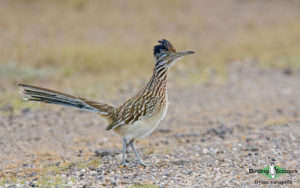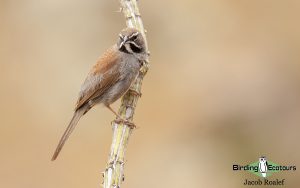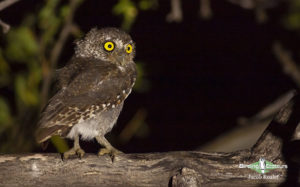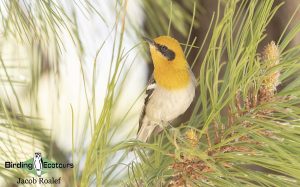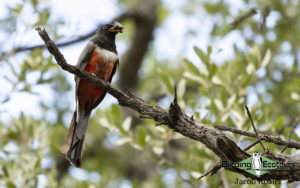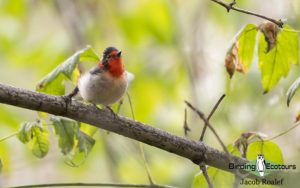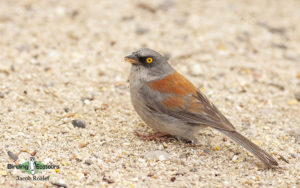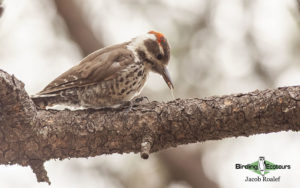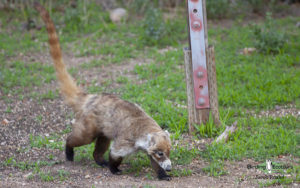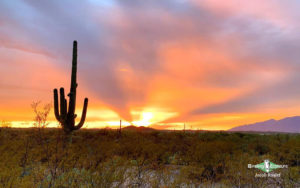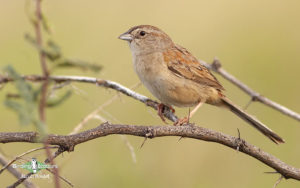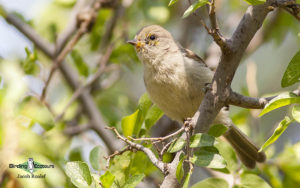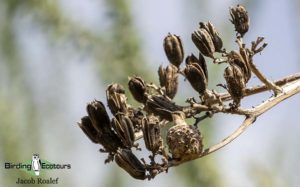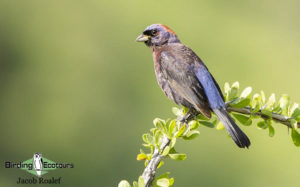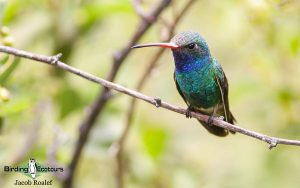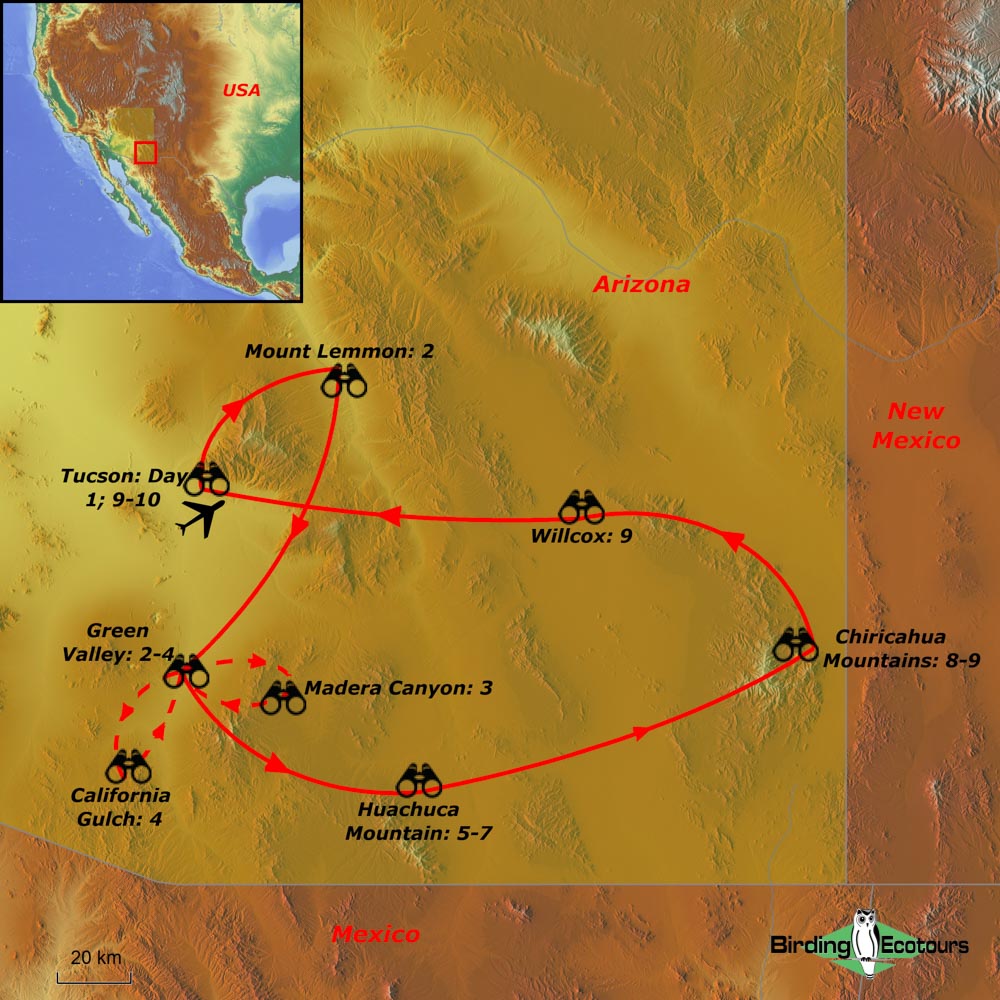Birding Tour USA: Comprehensive Southeast Arizona – The Desert and Sky Islands
Go to: Northern Arizona Birding Tour | USA Birding Tours | Birding Tours in North America | All our birding tours
Comprehensive Southeast Arizona – The Desert and Sky Islands
August 2024/2025
Southeast Arizona is a land of stark contrasts and spectacular scenery. In the lowlands, granite outcrops, towering Saguaro cacti, and sandy washes typify the Sonoran Desert, a landscape featured in so many ‘Western’ movies. The fabled Sonoran Desert is the home of such iconic species as Greater Roadrunner and Gambel’s Quail. Rising from the desert, isolated mountain ranges, clad in beautiful Madrean pine-oak woodland, provide a habitat found nowhere else in the United States. At remarkably cool (compared to the very hot desert plains below) higher elevations on these sky islands, pine forests can also sometimes be found. These forested mountain islands, with provocative names such as the Huachucas and Chiricahuas, are the northernmost outposts for a long list of primarily Mexican species such as Elegant Trogon and Mexican Chickadee. The canyons surrounding these mountains carry ephemeral streams to the parched lowlands below, creating ribbon-like groves of cottonwood that act as a conduit for even more tropical birds to enter south-eastern Arizona, such as Thick-billed Kingbird and Violet-crowned Hummingbird. Together, these contrasting habitats make southeast Arizona one of the most exciting regions to bird in North America, with more bird species than any other land-locked area of comparable size in the United States. With incredible birding areas like Cave Creek Canyon and the Ramsey Canyon Preserve and Nature Conservancy, it is no wonder why only California, Texas, and Florida have state lists longer than this relatively small region! The Arizona bird list boasts over 570 species! Of these species, 36 are only occasional anywhere else within the United States, making Arizona a must for North American birders.
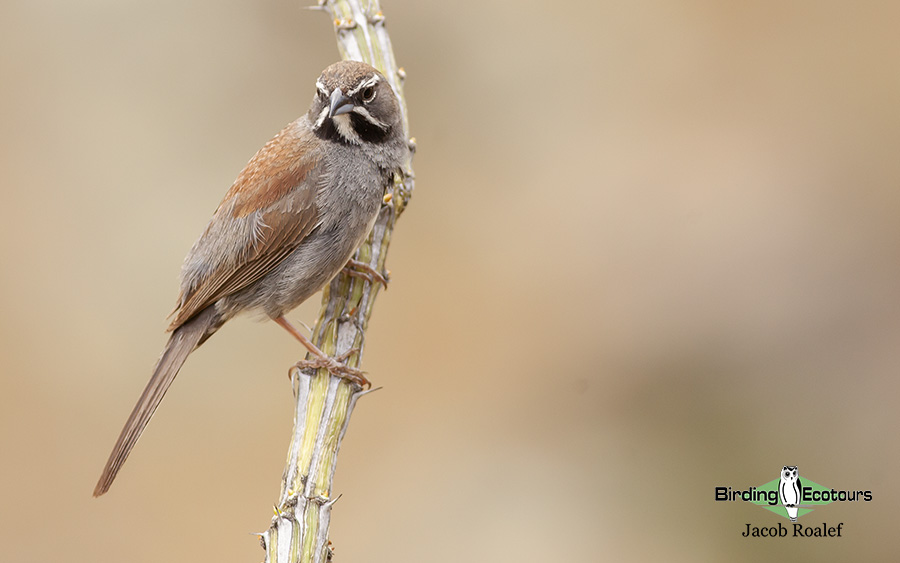
We begin this tour in the city of Tucson, where we explore the Sonoran Desert via Saguaro National Park, as well as travel up the impressive peak of Mt. Lemmon. In the southeast corner of the state, the Santa Ritas will provide us with our first true taste of birding the Madrean sky islands, with specialties such as Elegant Trogon. Further east we will punctuate our time spent in the upper elevation of the Huachucas with vigils at lowland hummingbird feeders for Violet-crowned Hummingbird and Lucifer Sheartail (Hummingbird). Heading even further east, we straddle the border with New Mexico and explore the Chiricahuas, which hosts more specialties like Mexican Chickadee and Olive Warbler.
If you combine this tour with our northern Arizona and Grand Canyon tour, you’ll be able to have the most comprehensive Arizona birding tour on offer and you’ll also be able to see a host of typical western species. It should also be noted that we run our southeast Arizona birding tour dates so you can combine it with the famous Southeast Arizona Birding Festival operated by the Tucson Audubon Society.
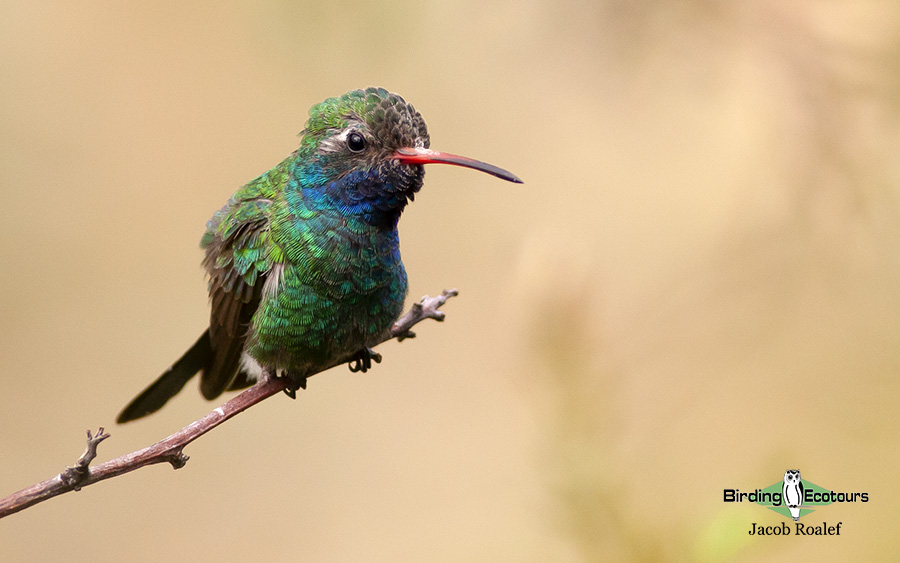
Itinerary (10 days/9 nights)
Day 1. Arrival in Tucson and initial birding
After arrival at the Tucson International Airport, participants will transfer to the hotel to get checked in. From here, we will head out for our first dinner and a chance to get to know each other better. Following dinner, those who choose to, can go out exploring for several nocturnal species like Lesser Nighthawk, Elf Owl and maybe even a Common Poorwill. Then it is back to the hotel for the night.
Overnight: Tucson
Day 2. Birding Mt. Lemmon to Madera Canyon
We will start the morning heading up to the tallest peak in the Santa Catalina Mountains, Mt. Lemmon, which stands at an impressive 9,159 feet (2,792 m). We have several stops planned along the way as we reach different habitat types with the ascending elevation. First stop, a quick scan through a huge Saguaro forest looking for Gilded Flicker, Black-tailed Gnatcatcher and Brown-crested Flycatcher. Further up, we will reach Rose Canyon Lake to search for several great birds including Common Black Hawk, Yellow-eyed Junco, and Pygmy Nuthatch. Higher and higher we go until we reach the pines near the top for high altitude species such as Broad-tailed Hummingbird, Hermit Warbler, Cordilleran Flycatcher, and the special Red-faced Warbler. After lunch and a bit more birding, we will start our descent of the mountains and continue south for our next session of birding in the sky islands.
We will stop in the town of Green Valley for dinner before heading back out for a relaxing evening watching the feeders at the Santa Rita Lodge in Madera Canyon. They regularly attract fantastic birds including Hepatic Tanager, Arizona Woodpecker, and Rivoli’s Hummingbird. In the past, the feeders have hosted several amazing rarities and perhaps one might be hanging around! As the sun sets, we will travel up to the top of the canyon and try for Mexican Whip-poor-will, Northern Pygmy Owl, and Whiskered Screech Owl. Then it is back to the hotel and time for bed.
Overnight: Green Valley
Day 3. Santa Rita Mountains birding
Today we will explore the canyons of the Santa Rita Mountains. Recent reports may dictate where we visit first, however there are loads of amazing birding areas here such as Box, Florida, and Madera Canyons. The past several years Box Canyon has hosted one or two breeding pairs of the rare Five-striped Sparrow. With any luck we will be able to score at least one of these along with Varied Bunting and Golden Eagle. Then we will visit Florida Canyon, the most reliable location for the special Black-capped Gnatcatcher, plus other great species like Northern Beardless Tyrannulet. Of course, we cannot forget about exploring Madera Canyon itself where we will spend more time searching the riparian areas for Elegant Trogon, Sulphur-bellied Flycatcher, Painted Redstart and more! Another evening brings another chance at nocturnal species if we were unsuccessful the previous night.
Overnight: Green Valley
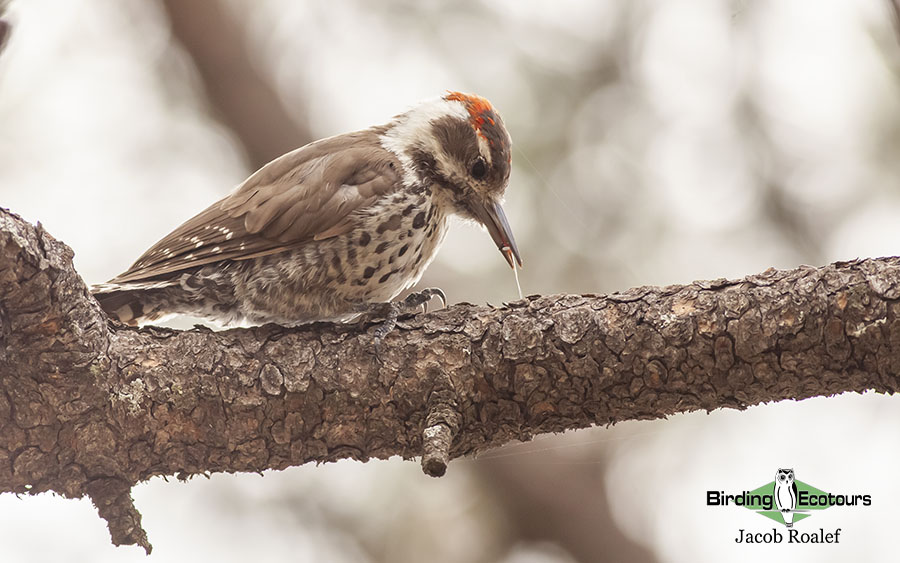
Day 4. California Gulch and more Santa Rita Mountains
Today starts off with some more morning birding in the Santa Rita Mountains targeting any species or locations we may have missed the previous day. Around midmorning, we are scheduled to make the journey to California Gulch. Until recently, this area was the only reliable and known spot to see the rare Five-striped Sparrow, of which it is estimated only 50 territorial males come to the US each year. Recently, a few more pairs have been discovered in easier-to-access locations, as the growing trend of southern breeding specialties shifting northwards continues. The other main attraction of California Gulch is the chance for Buff-collared Nightjar in the evening, as darkness engulfs the landscape. Our drive back out of this area will be a long one, but if the skies are clear we will be in for an amazing cosmic display as well as the chance for Common Poorwill on the roadsides. If we manage to get lucky and locate these species elsewhere, we will spend the day exploring the canyons of the Santa Ritas and save ourselves the long journey to the gulch.
Overnight: Green Valley
Day 5. Tubac/Tumacacori and transfer to Sierra Vista
The morning will begin with some enjoyable birding in the lowland riparian areas along the Santa Cruz river in Tubac and Tumacacori, before it gets too hot. Many fantastic species can be found here including a few nesting pairs of Rose-throated Becard in recent years, as well as Summer Tanager, Grey Hawk and Cassin’s Kingbird. We will continue our journey towards Sierra Vista with a few more stops along the way like at the relaxing Paton Center for various hummingbirds and the world-famous Patagonia Rest Area to search for specialties including Violet-crowned Hummingbird and Thick-billed Kingbird. We will also stop at Patagonia Lake State Park and the Sonoita Creek State Natural Area for a few water birds like Neotropic Cormorant and Mexican Duck, uncommon in the standard arid habitats surrounding it. Finally, we will arrive in the Huachuca Mountains where we will spend the remainder of the evening at the Ash Canyon Bird Sanctuary feeders, a favorite hangout of the Lucifer Sheartail (Hummingbird).
Overnight: Sierra Vista
Days 6-7. Birding the Huachuca Mountains
Straddling the border with Mexico, the Huachuca Mountains are the second of the Madrean sky islands on our itinerary, offering a slightly different set of specialties from the Santa Ritas, such as the semi-colonial Buff-breasted Flycatcher and the charismatic Spotted Owl. A series of canyon outlets on the eastern flank of these mountains, such as Carr, Ramsey, Hunter, and Miller Canyons, provide access to the pine-oak woodlands where these species occur. Occasionally rarities such as White-eared Hummingbird or Rufous-capped Warbler appear and we will adjust our plans accordingly to target these birds. In addition to the amazing canyon birding, the Sierra Vista area hosts several fantastic grassland habitats for us to explore, like Las Cienegas National Conservation Area and the San Pedro Riparian National Conservation Area. As the scrublands begin to bloom with the rain, the fantastic Cassin’s and Botteri’s Sparrows begin singing and establishing territories. The grasslands are also full of other great wildlife such as Burrowing Owl, Pronghorn Antelope and Black-tailed Prairie Dog. We will have two amazing days to explore this region that are sure to be filled to the brim with birds and fun!
Overnight: Sierra Vista
Day 8. Birding Portal and the Chiricahua Mountains
We will be up early this morning as we leave the Huachucas behind and head towards the final range of the sky islands. The Chiricahua Mountains, which means “Big Mountain” in Opata, rise spectacularly out of the surrounding desert as the single-largest mountain mass south of the Gila River in Arizona, while also boasting the most diverse land-locked plant and animal community in the United States. Starting in the lower-elevation desert valley around dawn, we explore the area around Big Thicket while we straddle the border with New Mexico searching for the ridiculously curve-billed Crissal Thrasher. As the day heats up, we retreat to the cooler forests along the South Fork Cave Creek Trail – a trail renowned for its breeding population of Elegant Trogon, the star of any birding trip to Arizona. More common specialties such as Bridled Titmouse, Mexican Jay, and Painted Redstart also occur here. Near the top, the Chiricahua Mountains claim the only accessible population of Mexican Chickadee on public lands in the United States, so we make a special effort to see them on this itinerary. The higher elevations also give us a nice opportunity for other great species such as Olive Warbler, Red Crossbill and Steller’s Jay. In the afternoon, we will drive up to the Paradise Road junction around East Turkey Creek in search of the above species. A little further along this road the old mining town of Paradise hosts excellent feeders, which attract the localized Juniper Titmouse.
Overnight: Portal
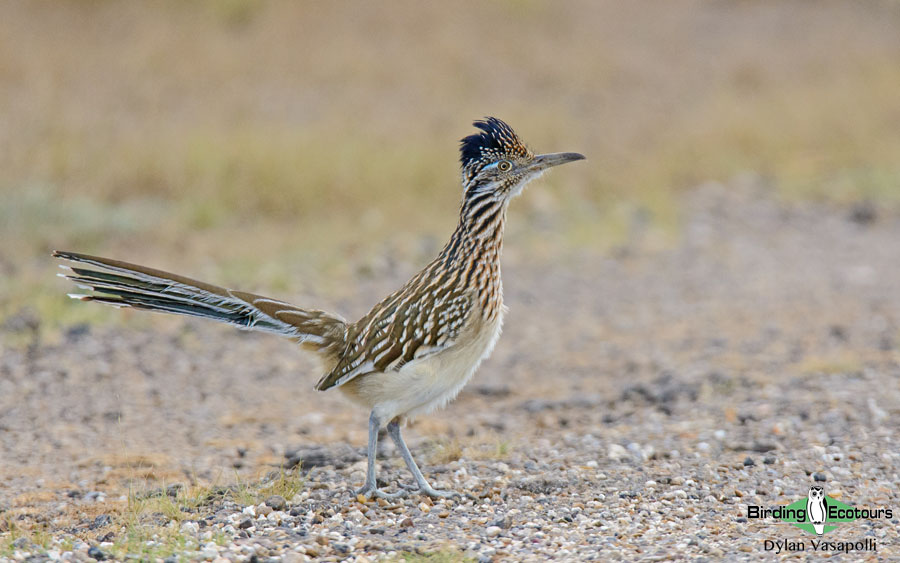
Day 9. Portal to Tucson
The next morning will be spent exploring the Chiricahuas a bit further in search of species missed the day before while also enjoying the incredibly scenic views these mountains have to offer. Driving the canyon roads early in the morning yields a good chance for a wandering Montezuma Quail to make an appearance. Another visit to local feeders is sure to produce the stellar Blue-throated Mountaingem, yet another hummingbird specialty of this region.
After a successful few days birding in the Chiricahua Mountains, we will say goodbye to the sky islands and start our journey back to Tucson, stopping at a few places along the way. First stop is Lake Cochise in Willcox, a true water oasis in the middle of the desert, stocked with plenty of thankful shorebirds and waterfowl. American Avocet, Wilson’s Phalarope and Cinnamon Teal are a few of the potential species here. After an enjoyable time scanning through these birds, we’ll continue on to St. David. This small town is known to host a few pairs of Mississippi Kite, the most westerly known population of this species. After dinner in Tucson, we will enjoy our final Sonoran Desert sunset as well as have a chance to track down any missing nocturnal species.
Overnight: Tucson
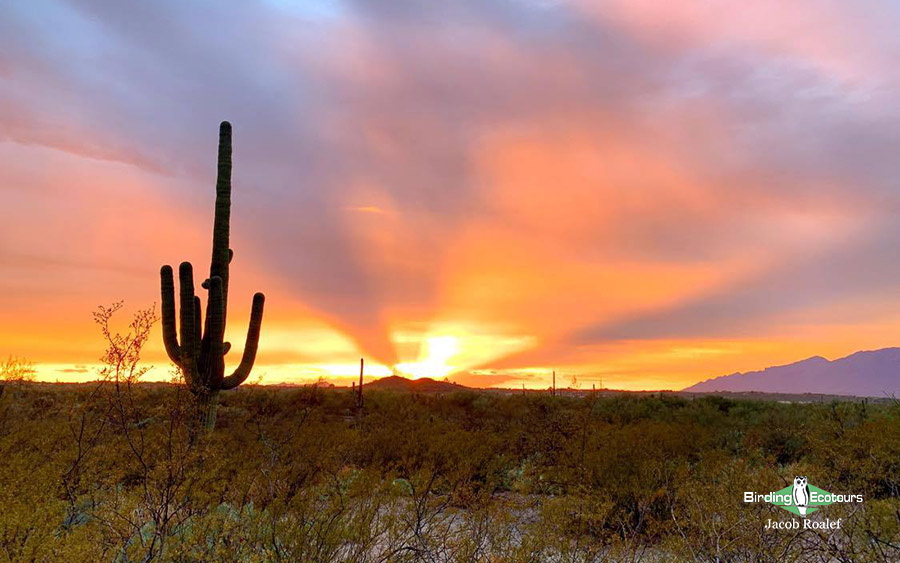
Day 10. Tour concludes
For some, the Desert and Sky Island Arizona tour concludes this morning after a successful run through the southeastern portion of the state. You will be dropped off at the Tucson International Airport for your flights home. For others, it may be the start of an exciting second itinerary, to northern Arizona. Participants joining the second tour will be transferred from Tucson to Phoenix for Day 1 of that itinerary.
Please note that the itinerary cannot be guaranteed as it is only a rough guide and can be changed (usually slightly) due to factors such as availability of accommodation, updated information on the state of accommodation, roads, or birding sites, the discretion of the guides and other factors. In addition, we sometimes have to use a different international guide from the one advertised due to tour scheduling.
Download ItineraryUSA – Southeast Arizona: The Desert and Sky Islands Birding Trip Report
14 – 23 AUGUST 2022
By Jacob Roalef
DOWNLOAD TRIP REPORT
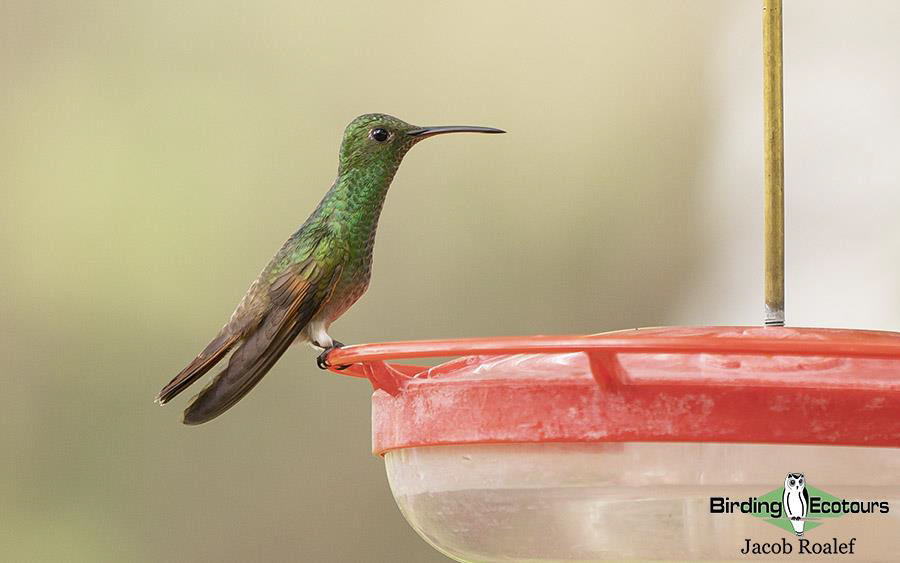
Overview
This ten-day set departure tour of Southeast Arizona commenced in Tucson, Arizona on the 14th of August 2022 and concluded back in Tucson on the 23rd of August 2022. On this tour we visited numerous fantastic birding locations including Santa Rita Lodge, Mt. Lemmon, Sweetwater Wetlands, Montosa Canyon, Paton’s Center for Hummingbirds, Ash Canyon B&B, Las Ciengas National Conservation Area, Rustler Park, the George Walker House and many more.
This tour connected with many fantastic target birds and regional specials, including 13 species of hummingbirds, giving us a quality list for our ten days in the desert. Avian highlights included Greater Roadrunner, Montezuma Quail, Lucifer and Violet-crowned Hummingbirds, Black Tern, Northern Goshawk, Zone-tailed Hawk, Western Screech-Owl, Arizona Woodpecker, Sulphur-bellied Flycatcher, Rock Wren, Five-striped, Botteri’s and Cassin’s Sparrows, Red-faced Warbler and Pyrrhuloxia. We were also able to see some rarities for Arizona including two Berylline Hummingbirds, White-eared Hummingbird and Ruddy Ground-Dove.
A total of 189 bird species were seen, with two additional heard only species bringing the total recorded to 191, which is a new record for this trip. In addition to the birds, some other animals were spotted including Pronghorn, Black-tailed Prairie-Dog, Harris’s Antelope Squirrel, Striped Skunk and a Desert Tarantula. Full bird and mammal checklists can be found at the end of the report.
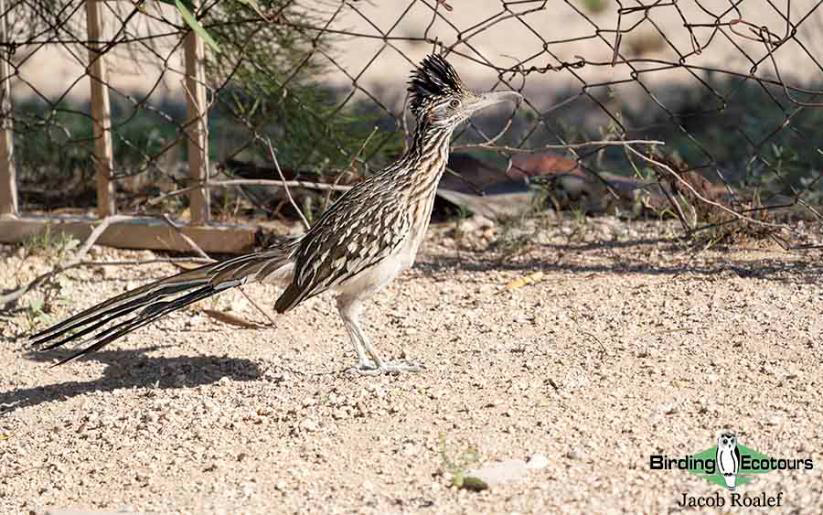
Detailed Report
Day 1, 14th August 2022. Arrival and Sweetwater Wetlands birding
The first morning of the trip was mainly spent gathering up some of the participants who were already in the area from the night before. We decided to head off and do some mid-morning birding at Sweetwater Wetlands. These lovely little oases near Tucson are a great introduction to desert birding and species and here we got our first taste of desert specials, including Vermillion Flycatcher, Ladder-backed Woodpecker, Abert’s Towhee and Verdin. After a tasty lunch, we ventured to another local park called Lakeside Lake where we saw a lingering and probably injured Snow Goose. This was a strange bird for the desert, in extreme heat. In addition to the goose, there was Lark Sparrow, Great-tailed Grackle and Gila Woodpecker. We headed to the airport to gather the rest of our group before heading to a superb Mexican food dinner. Sadly, an incoming monsoon prevented any evening birding, so we headed to the hotel for rest instead.
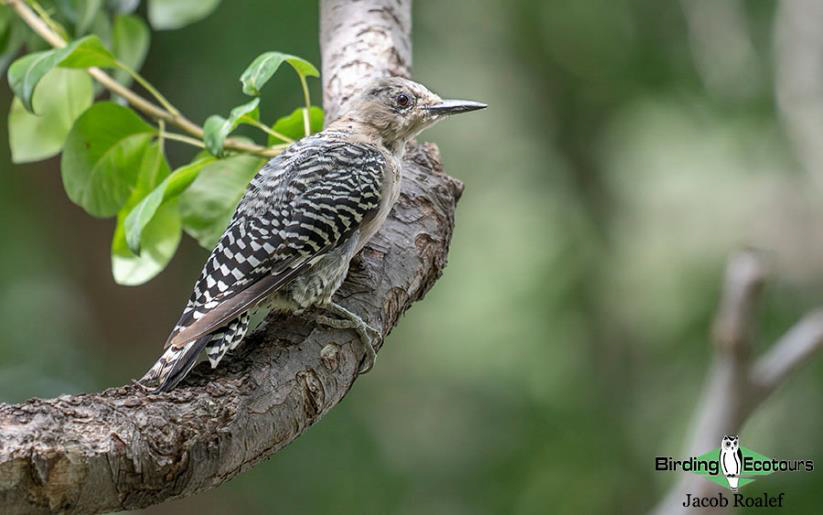
Day 2, 15th August 2022. Mt. Lemmon and down to Green Valley
We had breakfast and coffee at the hotel before loading up our van and heading up Mt. Lemmon. Our first stop on the way up was the Babad Do’ag Vista where we were surrounded by Saguaro Forest. Here in the desert lowlands, we noted a few species including Cactus Wren and Black-throated Sparrow before we continued our journey upwards. Pulling off at the Windy Point Vista, we enjoyed some spectacular views before a Zone-tailed Hawk cruised right over our heads! Down below us in the rocks and shrubs, we managed to find Rock Wren, Black-throated Grey Warbler and Mexican Jay. More driving and higher altitude led us to Rose Canyon Lake, an area full of conifers which were quite different from the cacti down at the bottom. Temperatures were pleasant and a lovely mixed flock kept us entertained with Red-faced, Grace’s and Hermit Warblers, Painted Redstart, Western Bluebird and Pygmy Nuthatch all present and an Olive Warbler made a brief appearance. Yellow-eyed Junco and the striking Acorn Woodpecker were plentiful throughout the area as well.
We traveled to the small town of Summerhaven on top of the mountain and enjoyed some pizza for lunch. We noted Steller’s Jay, Broad-tailed Hummingbird, Black-headed Grosbeak and Pine Siskin before making our way down the mountain and towards Green Valley.
Once we arrived in Green Valley, we headed straight for Santa Rita Lodge, a relaxing spot full of feeders, which always makes birding that bit easier. This was a great way to spend the remainder of the afternoon as we enjoyed Broad-billed and Rivoli’s Hummingbirds, Mexican Jay, Arizona Woodpecker, Bridled Titmouse and Lesser Goldfinch. It was back to Green Valley and dinner at the hotel after a long day of successful birding.
Day 3, 16th August 2022. Montosa Canyon and the Santa Rita Mountains
This morning we grabbed some coffee nearby and headed off to Montosa Canyon. It was a beautiful morning with a pleasant temperature and we began birding along a small creek and ridge of the canyon.
Right away we were onto some interesting species including Varied Bunting, Bell’s Vireo, Loggerhead Kingbird and Northern Mockingbird. We continued further along the road to a known location for our target species of the day. While we were searching, we managed to come across some other nice species such as Hooded Oriole and Crissal Thrasher. Finally, the Five-striped Sparrow began singing and flew down the slope to give us some incredible views, before moving back into the dense vegetation.
We headed back out of Montosa Canyon and got a nice breakfast at the hotel before spending the rest of the morning at Canoa Ranch Conservation Park and Desert Meadows Park in Green Valley. These lovely little parks held some great birds and despite the heat we picked up Redhead, Spotted Sandpiper, Swainson’s Hawk and Yellow-headed Blackbird. The Desert Meadows are full of native plants and birds. After a quick loop through the park, we had a list containing Bewick’s Wren, Broad-billed Hummingbird, Curve-billed Thrasher and Gambel’s Quail.
After lunch we took a little siesta before meeting up again for some evening birding. We headed back up Madera Canyon to the Old Baldy Trail, however the bird activity was slow. A few Mexican Jays, a Sulphur-bellied Flycatcher and a family of Acorn Woodpeckers highlighted our time here. We headed down the mountain slightly for a picnic style dinner and enjoyed views of a Hepatic Tanager while we ate. As the sun was setting, we headed back up to try for some night birding, however a huge monsoon rolled in right as it was getting dark and we had to bail out. It wasn’t raining at the bottom yet and we managed a new experience with some Lesser Nighthawks hunting the streetlights.
Day 4, 17th August 2022. Madera Canyon and Santa Gertrudis Lane
We headed back up Madera Canyon as we still had some unfinished business with a few key target species. We started off with a brief check-in at the Santa Rita Lodge feeders. Unfortunately the feeders were empty, but still hosted the usual suspects like Rivoli’s Hummingbird, Lesser Goldfinch and Mexican Jay.
We quickly moved on to the Old Baldy trail to take another hike up along the river. Again, the birding was rather slow and our targets nowhere to be found in their usual area. However, we did manage to see Painted Redstart, Acorn Woodpecker, Sulphur-bellied Flycatcher and Hutton’s Vireo.
We checked back in at the lodge which was now open and full of food. Action was certainly better than earlier in the morning with new species like Wild Turkey, Hepatic Tanager and Black-chinned Hummingbird. We waited for a while, staking out the feeders, while some of us visited the nice gift shop. After about 45 minutes, our target made a quick appearance, a brilliant Berylline Hummingbird and a true rarity for the United States.
We were feeling lucky and got a nice tip that the targets at the top of the mountain were hanging out further up than previous years, so we ventured back and hiked that trail for a third time. This time, we went even higher up and scored fantastic views of a male Elegant Trogon and a recently fledged juvenile! Our determination paid off.
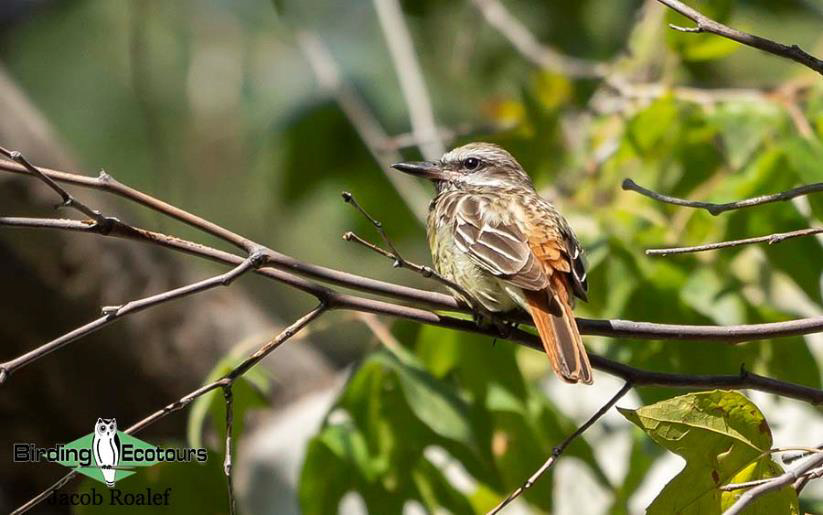
We headed back to Green Valley for lunch and a siesta before meeting again for some evening birding. We headed south to Santa Gertrudis Lane. This little area was hopping with great bird activity (and mosquitoes). Despite the biting insects around us, we had a fantastic time here, scoring species like Grey Hawk, Black Phoebe, Tropical Kingbird, Lucy’s Warbler, Summer and Western Tanagers, Indigo Bunting, Bullock’s Oriole and the regional special species Thick-billed Kingbird. It was a great way to close out an amazing day of birding.
Day 5, 18th August 2022. Through Patagonia and over to Sierra Vista
Leaving the Santa Rita Mountains behind, we headed off to the Huachuca Mountains. We went back to Canoa Ranch for our first stop, to give this location a shot in the morning before the temperatures began to soar. The birding was better and we observed Great Blue Heron, Pyrrhuloxia, Cassin’s Kingbird, Vermillion Flycatcher and American Kestrel.
From here we continued on our way to Patagonia with a quick drive-through stop at Patagonia Lake. We noted Black Vulture, Mexican Duck and Say’s Phoebe. Next up was the famous Patagonia roadside rest area. There was a small group of White-throated Swifts circling overhead to greet us as we disembarked from the van and headed across to the small trail. Along the trail we managed to find our target species, a nesting Rose-throated Becard. Unfortunately, we had to maintain distance as the female was frequently visiting the nest, her movements so fast that she made it near-impossible to catch a clear view. We gave it a while, hoping to catch a better glimpse, which a few of us managed, before we moved on and headed for lunch.
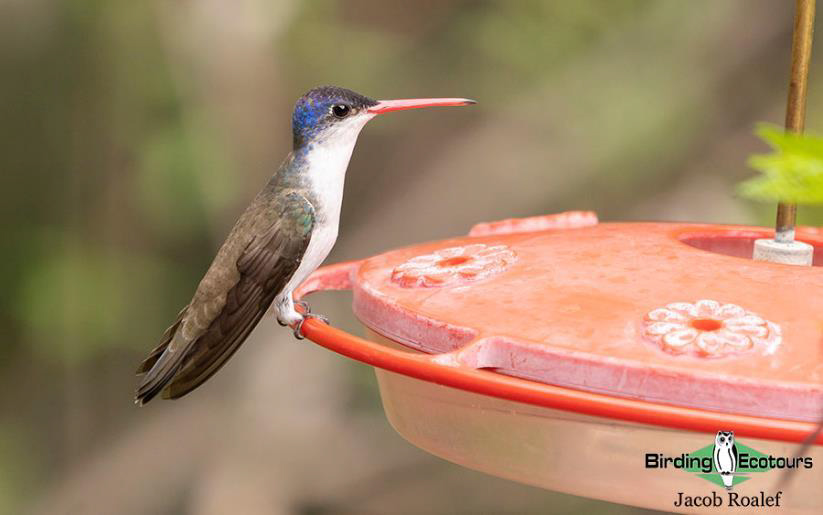
After lunch we visited the peaceful Paton Center for Hummingbirds. There was lots of bird activity here with the star of the yard, the Violet-crowned Hummingbird, making frequent appearances. Amazingly a Berylline Hummingbird dropped into the feeders three times, making it the second one in a single trip for us!
A few of us also managed views of the rare Ruddy Ground-Dove which had been visiting the yard on and off. In addition to these rarer species, we also saw Yellow-breasted Chat, Yellow-billed Cuckoo, Anna’s Hummingbird, Inca Dove, Green Heron and Northern Cardinal.
A quick cruise through the nearby neighborhood had us finding a Mississippi Kite. A pair were known to recently have a nest in this area, so it was great to catch up with one of these magnificent birds. We finally made it to the Huachuca Mountains and our first stop was the Ash Canyon B&B feeders. Possibly one of the most peaceful areas to bird, the yard was highlighted by Lucifer, Costa’s, Calliope and Rufous Hummingbirds, Ladder-backed Woodpecker and Black-headed Grosbeak. Another quick drive through a neighborhood had us enjoying some Scaled Quails in addition to many Gambel’s Quails. We finally settled down for a delicious Italian dinner after a top-notch day of birding.
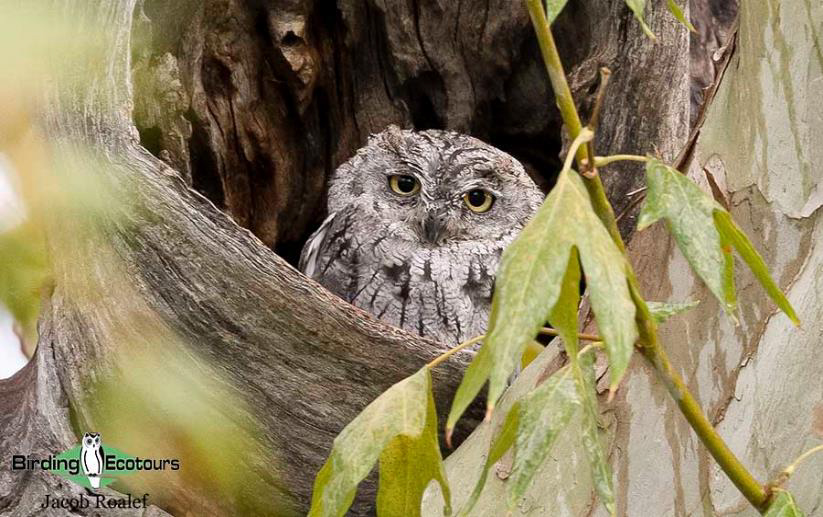
Day 6, 19th August 2022. Carr and Miller Canyons
After breakfast we headed up the rocky and bumpy switchbacks which led into Carr Canyon. The cooler air at this higher altitude was perfect for birding as we wandered the campsites throughout the morning. We came across several mixed flocks which included Cassin’s and Plumbeous Vireos, Grace’s, Black-throated Grey, Hermit and Red-faced Warblers, Brown Creeper, Northern Flicker and White-breasted Nuthatch.
We circled around for a few hours before finally spotting the top target of this site, the Buff-breasted Flycatcher! This little bird finally cooperated and gave us all a nice view. On our way back down the canyon, we spotted several other new species including Woodhouse’s Scrub-Jay, Virginia’s Warbler and Eastern Bluebird.
After lunch and a much-needed siesta, we headed back out for a little more birding. Along the entrance road to Brown Canyon we managed to find an adorable Western Screech-Owl sticking out of a tree cavity, despite the light rain. We then headed off to the Beatty’s Guest Ranch for a little feeder watch as we kept a careful eye on the sky and the storms looming nearby. Rivoli’s, Anna’s, Black-chinned and Broad-billed Hummingbirds highlighted the feeders here and we eventually called it a day as the rain began creeping in.
Day 7, 20th August 2022. Las Cienegas NCA and Whitewater Draw
The forecast for the day did not look promising so we routed the best we could to avoid storms and rain. Our first birding destination after breakfast was the grasslands of Las Cienegas National Conservation Area.
Right at the entrance we were greeted by singing Chihuahuan Meadowlarks (recently split from Eastern Meadowlark) and a Horned Lark perched along the wire fence. We drove through this massive area, scanning closer and listening for any activity, making stops whenever we spotted something. This area yielded some fantastic birds including Cassin’s, Botteri’s and Grasshopper Sparrows, Blue Grosbeak, Grey Flycatcher, Northern Harrier and Lark Bunting as well as a few sightings of Pronghorn.
Unfortunately, our progress was halted when we came across a stream rushing across the road. We had to turn around and go back to a different entrance to finish our birding and visit a colony of Black-tailed Prairie Dogs. Overall, it was a great morning and we managed to stay out of bad weather.
We headed towards the town of Tombstone for lunch and a little cowboy western scenery. After this we ventured out to Whitewater Draw, a body of water in the middle of desert habitat. We picked up tons of new species for the trip as we made a circle around the lake. Highlights included Eared Grebe, Ruddy Duck, Sora, Wilson’s Phalarope, Great Egret, Black and Forster’s Terns, Black Phoebe, American Yellow Warbler and Lazuli Bunting.
On our way out of the park we noticed a sign stating this was an owl roosting area and about 15 seconds later we were all enjoying views of a Great Horned Owl in the trees! Then a little further up we noticed a strange structure on a collapsed building, so we looked into the hole with our scope and there was the face of an American Barn Owl staring back at us. A five-minute whirlwind of unexpected owls. After this we headed back to Sierra Vista for dinner and to celebrate the day’s birding, where we managed to avoid the monsoons.
Day 8, 21st August 2022. Stateline Road and the Chiricahua Mountains
We set off before sunrise, as we had some distance to travel and wanted to be birding in the desert before it got too hot. After a quick stop in Douglass for restrooms, we made it to Stateline Road where an unkindness of Chihuahuan Ravens were waiting for us, allowing us time to better study and properly ID them. We continued along this road, with New Mexico on our right and Arizona on our left. We logged species such as Cactus Wren, Lark Sparrow, Lark Bunting, Loggerhead Shrike and Blue Grosbeak for our New Mexico list.
We then left the desert behind and headed into Portal and the Chiricahua Mountains. First up were some feeders in town where we picked up our first Blue-throated Mountain Gem as well as Canyon Towhee, Ladder-backed Woodpecker and a covey of Gambel’s Quails. It had been raining overnight and into the morning so we decided to go to Paradise first and let the river crossings up the mountain reduce a little. Paradise was home of George Walker House, another fantastic feeder setup. We were greeted by the pleasant host and owner, who gave us a full breakdown of the yard whilst we watched the feeders. It wasn’t long before the rare White-eared Hummingbird made a visit at a far feeder. This yard was also the best location in southern Arizona for Juniper Titmouse and it did not disappoint, as two birds made multiple visits to the feeders.
It was time to head up the mountain towards Rustler Park at the top. As we got higher, we got into a nice flock of birds along the road, so we hopped out. It turned out to be one of the best flocks of the whole trip! It was loaded with birds including Townsend’s, Grace’s, Hermit and Red-faced Warblers, Brown Creeper, Bridled Titmouse and the true regional special Mexican Chickadee. Not much further up the road we spotted a lone Band-tailed Pigeon perched in the distance. It would take a few more encounters before we all managed a view, but we did in the end.
After a nice picnic, we did some birding at the Pinery Campground and Rustler Park. Nothing new was seen but we did see another Mexican Chickadee as well as Hermit Warbler, Spotted Towhee and Painted Redstart. It was raining off and on throughout our time up the mountain, but overall things were pleasant and ok for birding. On our way down we had perhaps the best sighting of the trip, a Montezuma Quail in the middle of the road! We watched as it slowly crossed and walked into the grass next to the road allowing us all to see. Incredible! After dinner a few of us went out for some night-time exploring where we managed to score a curious Striped Skunk in the road, but the birds were being quiet.
Day 9, 22nd August 2022. Wilcox and back to Tucson
We headed back out to the desert along Stateline Road to look for new species. We came across our first Scott’s Oriole of the trip as well some other nice species like Bullock’s Oriole, Curve-billed Thrasher, Cassin’s Sparrow and Swainson’s Hawk. We then headed back to Portal and the feeders there.
The skies were clear and we had a few new sightings, like a Harris’s Antelope Squirrel. The real highlight had to be a juvenile Bronzed Cowbird following its ‘mom’ – a female Hooded Oriole – around as it was begging for food. After watching these birds eat, it was our turn for a delicious brunch. We loaded the van up and took off on our long trip back to Tucson. We stopped at the Pinery Campground again on our way out of the mountains and found a distant Great Horned Owl as well as our first House Wren of the trip.
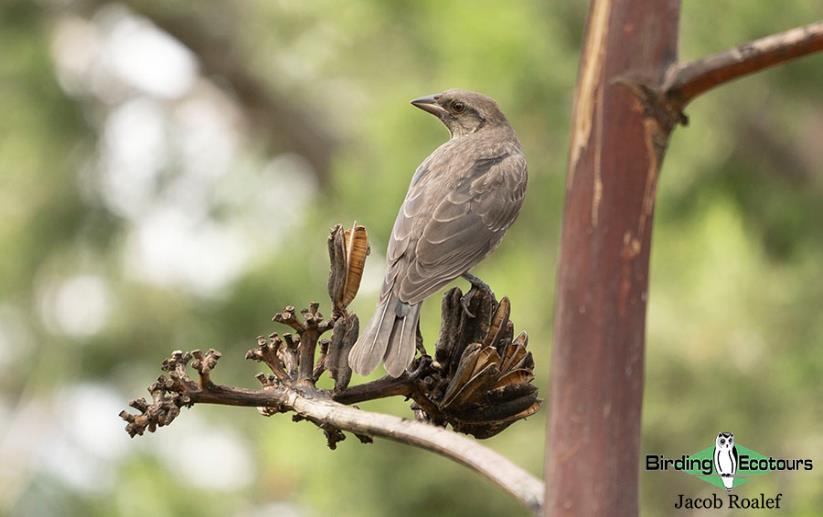
Continuing onwards, we made another stop at Lake Cochise in Wilcox. This location was loaded with waterbird species. We ticked off many species including Cinnamon and Green-winged Teals, American Avocet, Black-necked Stilt, Least and Western Sandpipers, Long-billed Dowitcher, Red-necked Phalarope and White-faced Ibis.
After another hour or so of driving, we made it into the outskirts of Tucson where we stopped for dinner. Since most evenings had been a rain-out so far, we decided to have another try and headed off to Saguaro National Park East. Desert birding here was enjoyable and highlighted by Rufous-winged Sparrow and Gilded Flicker. Scenery to match and a breath-taking desert sunset and rainbow helped us see the day out. As the sun set, we spotted a huge Desert Tarantula crossing the road. We headed off to our hotel for our final night of the tour.
Day 10, 23rd August 2022. Local Tucson birding and departure
After saying goodbyes, most of the participants were dropped off at the Tucson airport for their morning flights home. Two participants, however, did not have to leave until the afternoon, so we decided to do a little local birding at Reid Park. Before leaving the hotel, we were greeted by a friendly Greater Roadrunner next to the van and a Vermillion Flycatcher on the nearby fence.
Reid Park hosted a tiny pond which held mostly domestic farm ducks, however, there were a few interesting species including two new ones for the trip, American Wigeon and Neotropic Cormorant. This was a great way to finish off a very successful tour of Southeast Arizona! All the participants were asked to list their top five favorite species of the trip and the winners were Montezuma Quail, Elegant Trogon, Violet-crowned Hummingbird, Acorn Woodpecker and Red-faced Warbler.
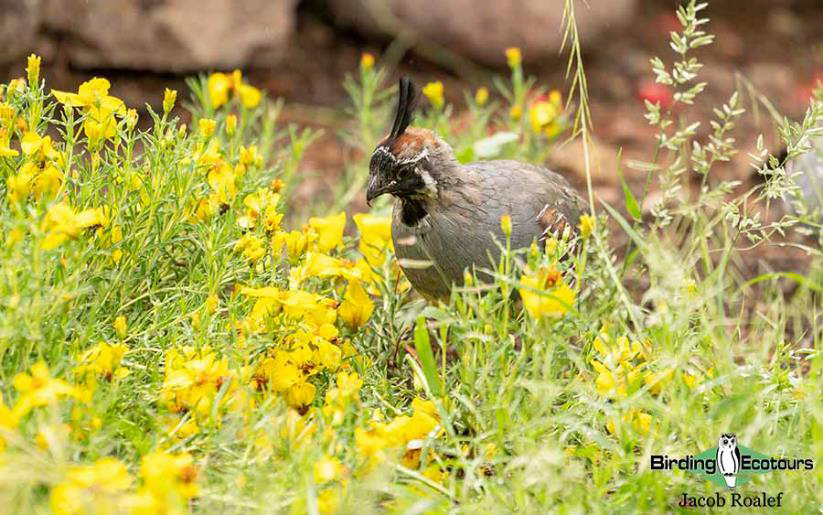
Bird List – Following IOC (12.2)
Birds ‘heard only’ are marked with (H) after the common name, all other species were seen. Species seen only on the pre-trip day of this trip are marked with (+) after the common name.
The following notation after species names is used to show conservation status following BirdLife International: CE = Critically Endangered, EN = Endangered, VU = Vulnerable, NT = Near Threatened.
| Common Name | Scientific Name |
| New World Quail (Odontophoridae) | |
| Scaled Quail | Callipepla squamata |
| Gambel’s Quail | Callipepla gambelii |
| Montezuma Quail | Cyrtonyx montezumae |
| Pheasants & Allies (Phasianidae) | |
| Wild Turkey | Meleagris gallopavo |
| Ducks, Geese, Swans (Anatidae) | |
| Snow Goose | Anser caerulescens |
| Blue-winged Teal | Spatula discors |
| Cinnamon Teal | Spatula cyanoptera |
| Northern Shoveler | Spatula clypeata |
| American Wigeon | Mareca americana |
| Mallard | Anas platyrhynchos |
| Mexican Duck | Anas diazi |
| Green-winged Teal | Anas crecca |
| Redhead | Aythya americana |
| Ruddy Duck | Oxyura jamaicensis |
| Nightjars (Caprimulgidae) | |
| Lesser Nighthawk | Chordeiles acutipennis |
| Swifts (Apodidae) | |
| White-throated Swift | Aeronautes saxatalis |
| Hummingbirds (Trochilidae) | |
| Rivoli’s Hummingbird | Eugenes fulgens |
| Blue-throated Mountaingem | Lampornis clemenciae |
| Lucifer Hummingbird | Calothorax lucifer |
| Black-chinned Hummingbird | Archilochus alexandri |
| Anna’s Hummingbird | Calypte anna |
| Costa’s Hummingbird | Calypte costae |
| Broad-tailed Hummingbird | Selasphorus platycercus |
| Rufous Hummingbird | Selasphorus rufus |
| Calliope Hummingbird | Selasphorus calliope |
| Broad-billed Hummingbird | Cynanthus latirostris |
| Violet-crowned Hummingbird | Amazilia violiceps |
| White-eared Hummingbird | Hylocharis leucotis |
| Berylline Hummingbird | Amazilia beryllina |
| Cuckoos (Cuculidae) | |
| Greater Roadrunner | Geococcyx californianus |
| Yellow-billed Cuckoo | Coccyzus americanus |
| Pigeons, Doves (Columbidae) | |
| Rock Dove (Pigeon) | Columba livia |
| Band-tailed Pigeon | Patagioenas fasciata |
| Eurasian Collared-Dove | Streptopelia decaocto |
| Inca Dove | Columbina inca |
| Common Ground Dove | Columbina passerina |
| Ruddy Ground Dove | Columbina talpacoti |
| White-winged Dove | Zenaida asiatica |
| Mourning Dove | Zenaida macroura |
| Rails, Crakes & Coots (Rallidae) | |
| Sora (H) | Porzana carolina |
| Common Gallinule | Gallinula galeata |
| American Coot | Fulica americana |
| Grebes (Podicipedidae) | |
| Pied-billed Grebe | Podilymbus podiceps |
| Eared Grebe | Podiceps nigricollis |
| Stilts and Avocets (Recurvirostridae) | |
| Black-necked Stilt | Himantopus mexicanus |
| American Avocet | Recurvirostra americana |
| Plovers (Charadriidae) | |
| Killdeer | Charadrius vociferus |
| Sandpipers, Snipes (Scolopacidae) | |
| Least Sandpiper | Calidris minutilla |
| Western Sandpiper | Calidris mauri |
| Long-billed Dowitcher | Limnodromus scolopaceus |
| Wilson’s Phalarope | Phalaropus tricolor |
| Red-necked Phalarope | Phalaropus lobatus |
| Spotted Sandpiper | Actitis macularius |
| Greater Yellowlegs | Tringa melanoleuca |
| Lesser Yellowlegs | Tringa flavipes |
| Gulls, Terns, Skimmers (Laridae) | |
| Forster’s Tern | Sterna forsteri |
| Black Tern | Chlidonias niger |
| Cormorants, Shags (Phalacrocoracidae) | |
| Neotropic Cormorant | Phalacrocorax brasilianus |
| Ibises, Spoonbills (Threskiornithidae) | |
| White-faced Ibis | Plegadis chihi |
| Herons, Bitterns (Ardeidae) | |
| Great Blue Heron | Ardea herodias |
| Great Egret | Ardea alba |
| Green Heron | Butorides virescens |
| New World Vultures (Cathartidae) | |
| Black Vulture | Coragyps atratus |
| Turkey Vulture | Cathartes aura |
| Kites, Hawks, Eagles (Accipitridae) | |
| Mississippi Kite | Ictinia mississippiensis |
| Northern Harrier | Circus hudsonius |
| Cooper’s Hawk | Accipiter cooperii |
| Northern Goshawk | Accipiter gentilis |
| Grey Hawk | Buteo plagiatus |
| Swainson’s Hawk | Buteo swainsoni |
| Zone-tailed Hawk | Buteo albonotatus |
| Red-tailed Hawk | Buteo jamaicensis |
| Barn Owls (Tytonidae) | |
| American Barn Owl | Tyto furcata |
| Owls (Strigidae) | |
| Western Screech-Owl | Megascops kennicottii |
| Great Horned Owl | Bubo virginianus |
| Trogons (Trogonidae) | |
| Elegant Trogon | Trogon elegans |
| Woodpeckers (Picidae) | |
| Acorn Woodpecker | Melanerpes formicivorus |
| Gila Woodpecker | Melanerpes uropygialis |
| Ladder-backed Woodpecker | Dryobates scalaris |
| Hairy Woodpecker | Dryobates villosus |
| Arizona Woodpecker | Dryobates arizonae |
| Northern Flicker | Colaptes auratus |
| Gilded Flicker | Colaptes chrysoides |
| Caracaras, Falcons (Falconidae) | |
| American Kestrel | Falco sparverius |
| Tyrant Flycatchers, Calyptura (Tyrannidae) | |
| Greater Pewee | Contopus pertinax |
| Western Wood-Pewee | Contopus sordidulus |
| Cordilleran Flycatcher | Empidonax occidentalis |
| Buff-breasted Flycatcher | Empidonax fulvifrons |
| Grey Flycatcher | Empidonax wrightii |
| Black Phoebe | Sayornis nigricans |
| Say’s Phoebe | Sayornis saya |
| Vermilion Flycatcher | Pyrocephalus rubinus |
| Brown-crested Flycatcher | Myiarchus tyrannulus |
| Sulphur-bellied Flycatcher | Myiodynastes luteiventris |
| Tropical Kingbird | Tyrannus melancholicus |
| Cassin’s Kingbird | Tyrannus vociferans |
| Thick-billed Kingbird | Tyrannus crassirostris |
| Western Kingbird | Tyrannus verticalis |
| Tityras and Allies (Tityridae) | |
| Rose-throated Becard | Pachyramphus aglaiae |
| Shrikes (Laniidae) | |
| Loggerhead Shrike | Lanius ludovicianus |
| Vireos, Greenlets, Shrike-babblers (Vireonidae) | |
| Bell’s Vireo | Vireo bellii |
| Hutton’s Vireo | Vireo huttoni |
| Cassin’s Vireo | Vireo cassinii |
| Plumbeous Vireo | Vireo plumbeus |
| Warbling Vireo | Vireo gilvus |
| Crows, Jays (Corvidae) | |
| Steller’s Jay | Cyanocitta stelleri |
| Woodhouse’s Scrub-Jay | Aphelocoma woodhouseii |
| Mexican Jay | Aphelocoma wollweberi |
| Chihuahuan Raven | Corvus cryptoleucus |
| Northern (Common) Raven | Corvus corax |
| Silky-flycatchers (Ptiliogonatidae) | |
| Phainopepla | Phainopepla nitens |
| Tits, Chickadees (Paridae) | |
| Mountain Chickadee | Poecile gambeli |
| Mexican Chickadee | Poecile sclateri |
| Bridled Titmouse | Baeolophus wollweberi |
| Juniper Titmouse | Baeolophus ridgwayi |
| Penduline-Tits (Remizidae) | |
| Verdin | Auriparus flaviceps |
| Larks (Alaudidae) | |
| Horned Lark | Eremophila alpestris |
| Swallows, Martins (Hirundinidae) | |
| Purple Martin | Progne subis |
| Tree Swallow | Tachycineta bicolor |
| Violet-green Swallow | Tachycineta thalassina |
| Bank Swallow | Riparia riparia |
| Barn Swallow | Hirundo rustica |
| Cliff Swallow | Petrochelidon pyrrhonota |
| Bushtits (Aegithalidae) | |
| Bushtit | Psaltriparus minimus |
| Wrens (Troglodytidae) | |
| Rock Wren | Salpinctes obsoletus |
| Canyon Wren (H) | Catherpes mexicanus |
| House Wren | Troglodytes aedon |
| Bewick’s Wren | Thryomanes bewickii |
| Cactus Wren | Campylorhynchus brunneicapillus |
| Nuthatches (Sittidae) | |
| White-breasted Nuthatch | Sitta carolinensis |
| Pygmy Nuthatch | Sitta pygmaea |
| Treecreepers (Certhiidae) | |
| Brown Creeper | Certhia americana |
| Mockingbirds, Thrashers (Mimidae) | |
| Curve-billed Thrasher | Toxostoma curvirostre |
| Crissal Thrasher | Toxostoma crissale |
| Northern Mockingbird | Mimus polyglottos |
| Starlings, Rhabdornis (Sturnidae) | |
| Common (European) Starling | Sturnus vulgaris |
| Thrushes (Turdidae) | |
| Eastern Bluebird | Sialia sialis |
| Western Bluebird | Sialia mexicana |
| Hermit Thrush | Catharus guttatus |
| American Robin | Turdus migratorius |
| Old World Sparrows, Snowfinches (Passeridae) | |
| House Sparrow | Passer domesticus |
| Olive Warbler (Peucedramidae) | |
| Olive Warbler | Peucedramus taeniatus |
| Finches, Euphonias (Fringillidae) | |
| House Finch | Haemorhous mexicanus |
| Pine Siskin | Spinus pinus |
| Lesser Goldfinch | Spinus psaltria |
| New World Sparrows (Passerellidae) | |
| Rufous-winged Sparrow | Peucaea carpalis |
| Botteri’s Sparrow | Peucaea botterii |
| Cassin’s Sparrow | Peucaea cassinii |
| Grasshopper Sparrow | Ammodramus savannarum |
| Chipping Sparrow | Spizella passerina |
| Black-throated Sparrow | Amphispiza bilineata |
| Five-striped Sparrow | Amphispiza quinquestriata |
| Lark Sparrow | Chondestes grammacus |
| Lark Bunting | Calamospiza melanocorys |
| Yellow-eyed Junco | Junco phaeonotus |
| Song Sparrow | Melospiza melodia |
| Canyon Towhee | Melozone fusca |
| Abert’s Towhee | Melozone aberti |
| Spotted Towhee | Pipilo maculatus |
| Yellow-breasted Chat (Icteriidae) | |
| Yellow-breasted Chat | Icteria virens |
| Oropendolas, Orioles, Blackbirds (Icteridae) | |
| Yellow-headed Blackbird | Xanthocephalus xanthocephalus |
| Chihuahuan Meadowlark | Sturnella lilianae |
| Hooded Oriole | Icterus cucullatus |
| Bullock’s Oriole | Icterus bullockii |
| Scott’s Oriole | Icterus parisorum |
| Red-winged Blackbird | Agelaius phoeniceus |
| Bronzed Cowbird | Molothrus aeneus |
| Brown-headed Cowbird | Molothrus ater |
| Great-tailed Grackle | Quiscalus mexicanus |
| New World Warblers (Parulidae) | |
| Orange-crowned Warbler | Oreothlypis celata |
| Lucy’s Warbler | Oreothlypis luciae |
| Virginia’s Warbler | Oreothlypis virginiae |
| Common Yellowthroat | Geothlypis trichas |
| American Yellow Warbler | Setophaga petechia |
| Grace’s Warbler | Setophaga graciae |
| Black-throated Gray Warbler | Setophaga nigrescens |
| Townsend’s Warbler | Setophaga townsendi |
| Hermit Warbler | Setophaga occidentalis |
| Red-faced Warbler | Cardellina rubrifrons |
| Wilson’s Warbler | Cardellina pusilla |
| Painted Redstart | Myioborus pictus |
| Cardinals & Allies (Cardinalidae) | |
| Hepatic Tanager | Piranga flava |
| Summer Tanager | Piranga rubra |
| Western Tanager | Piranga ludoviciana |
| Northern Cardinal | Cardinalis cardinalis |
| Pyrrhuloxia | Cardinalis sinuatus |
| Black-headed Grosbeak | Pheucticus melanocephalus |
| Blue Grosbeak | Passerina caerulea |
| Lazuli Bunting | Passerina amoena |
| Indigo Bunting | Passerina cyanea |
| Varied Bunting | Passerina versicolor |
| Total Seen | 189 |
| Total Heard | 2 |
| Total Recorded | 191 |
Mammal List
| Common Name | Scientific Name |
| Squirrels and Relatives (Sciuridae) | |
| Harris’s Antelope Squirrel | Ammospermophilus harrisii |
| Black-tailed Prairie Dog | Cynomys ludovicianus |
| Rock Squirrel | Otospermophilus variegatus |
| Arizona Grey Squirrel | Sciurus arizonensis |
| Round-tailed Ground Squirrel | Xerospermophilus tereticaudus |
| Cliff Chipmunk | Neotamias dorsalis |
| Rabbits and Hares (Leporidae) | |
| Black-tailed Jackrabbit | Lepus californicus |
| Desert Cottontail | Sylvilagus audubonii |
| Canids (Canidae) | |
| Coyote | Canis latrans |
| Skunks (Mephitidae) | |
| Striped Skunk | Mephitis mephitis |
| Raccoons and Relatives (Procyonidae) | |
| White-nosed Coati | Nasua narica |
| Deer, Elk, Mooses (Cervidae) | |
| White-tailed Deer | Odocoileus virginianus |
| Pronghorn (Antilocapridae) | |
| Pronghorn | Antilocapra americana |
| Total Recorded | 13 |
DOWNLOAD TRIP REPORT
Please see the downloadable PDF above with the full species lists included. This is a sample trip report. Please email us ([email protected]) for more trip reports from this destination.
GENERAL INFORMATION ARIZONA
Thanks for considering or booking our Arizona tour! With any luck we may soon be looking at Grey Hawk, Thick-billed Kingbird, Violet-crowned Hummingbird, and many more new and exciting species. In addition we may find one or two real local rarities, such as Yellow Grosbeak, Rufous-capped Warbler, or Roseate Spoonbill. On a prior tour we found Purple Gallinule! Hummingbirds almost always put on a great show, and we will make every possible attempt to see California Condor at the Grand Canyon.
FLIGHTS
Please inform us if any of your flights, times, or arrangements change. During your air travel to Tucson you will need to have your flight schedule and valid passport (or photo ID for US citizens) readily accessible. Increased security measures have been implemented at all airports to insure safer travel. If you have not flown in recent months you may wish to contact your travel agent, airline, or departure airport for current requirements. Arrive at the airport in plenty of time, be patient and cooperative, and be prepared for you and your luggage to be thoroughly checked. Smile and say “thank you” when everyone is finished.
TRIP INSURANCE
You should purchase travel insurance and trip cancellation insurance to protect your investment in case of injury or illness to you or your family prior to or during the tour. One supplier of this coverage that we suggest is Allianz Travel Insurance, The World Access Building, 2805 North Parham Road, Richmond, VA 23294, USA. Their toll-free phone numbers are 1-866-884-3556, 1-855-284-0331, and 1-800-284-8300.You can apply by phone or, for US residents, via the Internet here.
IDENTIFICATION
We will not cross the border into Mexico during the tour, but we may pass through one or more border patrol checkpoints within the US. Please bring proof of citizenship if you are not a US citizen. A passport is always acceptable.
WALKING AND CONDITIONS
There is a moderate amount of walking each day of the tour. These walks are not fast-paced and for the most part not terribly strenuous, although they may be a bit hilly and rocky. We try to do most of our walking early in the day before it gets too warm. A possible walk up Miller Canyon to look for Spotted Owl is one of the more strenuous walks, even though it is only about a two-mile round trip. We may also go into Florida Canyon and California Gulch. We will take our time and do a lot of birding along the way. These walks are always optional, but are planned to provide you with the best possible birding opportunities. We will do our best to make another arrangement if you do not wish to join a particular walk. A good regime of exercising and walking from now until the tour begins will help make things easier and more enjoyable for you on the tour.
WEATHER
You can expect temperatures to range from 60 °F (15 °C) to the low 90 ºF (33 °C) for much of the tour. There may be some cooler temperatures early and late in the day, especially in the mountains. On the other hand there may be a few days that are a bit warmer. We do our best to stay out of the really hot areas at midday and spend our time in the shady, cooler mountains and canyons. There is a daily chance of some desirable rain, so a raincoat can be handy and double as a jacket on a chilly evening when looking for Elf Owl or Common Poorwill. A little rain will cool the temperatures considerably and make the birds more active. A small umbrella can be very handy to keep you and your binoculars dry. It is always best to have your raingear in the van, just in case.
TRANSPORT
The step into our Ford Transit 12-passenger van is approximately 14 inches (35 centimeters) high, not much higher than on an average van. Please let us know if a small step stool would be useful for you.
DRINKS
We drink plenty of water every day. Please remember to bring a personal water bottle with you. There will be gallon jugs of water in the van from which to fill your personal bottle. Please let us know if you have any other favorite drinks, such as sodas or juice. Your guide will buy these at the grocery store and then have them in a cooler in the van. We need to know your exact preferences, especially caffeinated versus decaffeinated. There are probably ten different kinds of Coke, so please be as specific as possible. Upon your request your guide will purchase wine or beer for you, if you wish, for the end of the day. Again, please be specific with your request, and your guide will do his best to get just what you prefer. You can reimburse him for any wine or beer at a later time, as the cost of alcoholic drinks is not included in the tour fee.
PACKING LIST
Items that we suggest you bring, based upon years of experience in Arizona, include:
Loose, comfortable clothing.
Sweatshirt, sweater, or jacket
Raincoat and small umbrella. Your raincoat can also serve as a windbreaker.
Plastic bags to protect equipment and hold wet or dirty gear
A hat for sun protection and to reduce glare
Sunglasses will be useful.
Comfortable walking shoes and hiking boots. If you bring new ones be certain to break them in before the tour. Open-toed shoes (sandals, flip-flops) are okay around the lodge or going to dinner, but not while birding.
Sunscreen and insect repellent. Some people add a long-sleeved shirt for extra protection.
Hand sanitizer
Alarm clock and flashlight, with extra batteries for both. Each person should have a flashlight.
Binoculars are a necessity. The better the quality and condition of your binoculars, the more you will enjoy the birds and wildlife that you observe.
The guide will have a high-quality spotting scope to share with the group. If you have a scope and are willing to bring it, please let us know. We would like to have at least one additional scope if possible.
Camera and chargers
Personal water bottle, so that you can carry water with you during our walks. This is not optional; it is an absolute necessity so that everyone remains healthy and hydrated. There will be gallon jugs of water in the van for you to fill your personal bottle.
You may want to bring a few of your favorite snacks. There will be fruit, crackers, cookies, and a variety of drinks in the van.
Daypack or fanny pack to carry personal items during our walks
Health insurance card
Any prescription medicines you will need for the length of the tour, which you should pack in your carry-on. Aspirin, hydrocortisone cream, and antibiotic cream may be useful. There will be a basic first aid kit in the van.
Tweezers can be extremely useful to remove an unwanted cactus spine. Put them in your checked luggage, not in your carry-on because they would be confiscated at the security gate.
Helpful field guides include National Geographic, Robbins, or Peterson’s Western Guide. Many people use the Sibley or Kaufman field guide. Identification apps on your phone are becoming increasingly popular and useful.
Mammal, reptile, wildflower, cactus, and other nature guides are always helpful.
Airline schedule, passport (or photo ID if you are a US citizen)
When you pack your suitcase keep in mind that there is no guarantee that it will arrive in Tucson when you do. Probably it will, usually it does, but it may not. Thus your carry-on luggage is very important. Pack in your carry-on everything that you absolutely must have for the first few days, including a change of clothes, binoculars, all medications for the entire tour, airline schedule, passport or photo ID, money, and other essential items. Either wear comfortable hiking shoes or put a pair in your carry-on. Open-toed shoes are not advised for birding. Sandals and cacti do not mix! Items such as scissors, nail clippers, tweezers, tools, anything sharp, or anything that could be construed as a weapon should be in your checked luggage, not in your carry-on.
Two small bags are much easier to handle when loading the van as opposed to one large one. You can do laundry at several of our motels. So if you want to pack light plan on enough clothes for five to six days and do a load of laundry along the way. You may want to bring a small container of laundry detergent.
‘The Southeast Arizona tour is in the perfect area to see the maximum number of species and rarities. This tour has the perfect guide, Jacob Roalef, who works diligently to make sure that each participant sees all the birds he finds. This tour has the perfect number of participants to have fun, share knowledge and get to know each other. I would highly recommend this tour!
Jacob was an outstanding guide and I can’t say enough good things about him!. First, he knew the birds and could identify them by ear and sight. He made sure that each of us saw the bird(s) he had heard, seen or scoped. He also provided information about field marks, habitat, behavior and other interesting facts about the birds. Additionally, he knew a lot about the environment and gave us good context for the area that our tour covered. He was very diligent in finding the “rarities,” and then persistent until we saw them. Jacob also was very perceptive about each individual on the tour and gave equal attention to each of us based on our skill level in birding and our personal quirks. He is fun and funny, patient and well-organized and a safe and good driver. I innocently asked if there had ever been a flat tire on ones of his tours and that jinxed us because we indeed had one at 7,800 feet after a rain. Jacob was cool, calm and collected and what could have been a disaster ended with hilarity and a Band-tailed Pigeon. He facilitated and contributed to the camaraderie and banter that our group shared. I hope to go on another tour that Jacob guides.’
Sue

